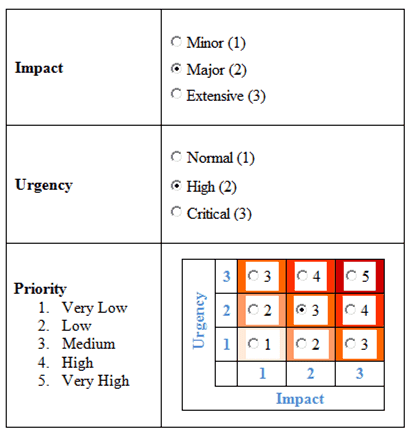This blog is intended to cover various aspects of core IT functions that include infrastructure, database, and application.
Thursday, November 27, 2014
Wednesday, May 28, 2014
Relationships among Impact, Urgency, and Priority in the context of Change Management
Impact:
Impact is a measure of the effect the change can cause on business.
Urgency:
Urgency is a measure of the situation, condition, or state that dictates how fast the execution of the change
is required. It is influenced by the impact along with other factors.
Priority:
Priority is a measure of the precedence given to the execution of the
change. Usually, it is automatically
assigned according to the values considered for Impact and Urgency (Figure 01).
Figure
01: Priority based on Impact and Urgency
Tuesday, March 25, 2014
Identifying True Skill Set for an IT Employee
Sometimes, an employee holding an IT title given by a non-technical manager may not have the required qualifications for the title. In other times, vendor or product-based (e.g., Basis Administrator by SAP, ArcSDE Administrator for ESRI's ArcSDE product etc.) title may hide the qualifications found in standard IT titles. In both cases, the following or similar steps may help identify the true skill set for an IT employee:
- What are the MAJOR software, tools, and/or programming languages you use for your everyday work?
- What are the MAJOR underlying hardware and/or software technologies used for the items identified in Step 1?
- Do you NATIVELY work with most aspects of the items identified in Step 2 (if yes, list the items)?
- What are the IT services your work DIRECTLY dependent on and/or affected by and you do NOT have control over?
- What is the broad IT function MOST of your knowledge, experience, and/or skills fall under?
Wednesday, March 19, 2014
Defining IT Strategy
Strategy, as
defined in the Oxford dictionary, is “a plan of action designed to achieve a
major or overall aim”. This definition
is not as specific as what is provided by Dr. Max McKeown (20111), which is “the
human attempt to get to desirable ends with available means”.
I find Dr.
McKeown’s definition more relevant to defining IT Strategy, especially for the
terms “human attempt” and “available means”.
In the context of IT, his defining terms can be elaborated as follows:
- Human Attempt: An IT professional’s high-level plan through research, analysis, synthesis, and leadership.
- Desirable Ends: Solutions to an IT department’s existing problems or new initiatives
- Available Means: An IT department’s assets (as provided below), vendors, and consultants:
- Employees
- Infrastructure, tools, and techniques
- Processes, policies, and standards
- Employees’ educations, experiences, and skills
Friday, February 21, 2014
An Overview of a DBA
Who is a DBA?
A DBA is an IT professional, who maintains,
manages, and administers databases and the Database Management Systems (DBMS)
that store those databases. A DBA mainly deals with enterprise DBMSs
(e.g., Oracle, SQL Server etc.) that contrast with personal DBMSs (e.g.,
Access).
The acronym DBA stands for Database
Administrator, not Database Analyst. A database analyst, however, can
assume the role of a DBA. A DBA focuses mostly on management and
administration, but a Database Analyst focuses mostly on development and
management.
Formal vs. Tool-Based DBA
A Formal DBA is an IT professional, who
usually has a degree in Computer Science, starts his/her career as a
programmer/analyst, and specializes in all aspects of databases, DBMSs, and
related technologies by assimilating broader aspects of computing.
A Tool-Based DBA is an IT
professional, who usually has a degree in a discipline other than Computer
Science, primarily learns to use only the tools and techniques associated with a DBMS, and lacks the of knowledge of broader aspects of computing.
The following diagram "Career Path of a DBA" shows
academic background and areas of work experience for a DBA, which also
differentiates a Formal DBA from a Tool-Based DBA:
Role of a DBA in an Organization
If an organization is thought as a human
body, then an enterprise Database Management System is its heart, the data are
its blood-cells, and the information generated from the data is its
blood. A Database Analyst is the haematologist and a DBA is the heart
specialist for the organization.
A DBA can be viewed as an all-in-one IT resource for the
organization, as he/she has experience in the core IT functions identified in
the following diagram:
An enterprise DBMS, along with its associated applications, is
relatively the most expensive software for its functionality and necessity in
an organization. A DBA maximizes the organization’s Return on
Investment (ROI) by exploiting the DBMS’ fullest
potential and helping developers make efficient and secure applications.
A DBA stays vigilant for an organization’s
business applications and information repositories to avoid data loss,
protect data security, ensure data availability, and maintain data compliance.
Major Tasks of a DBA
- Evaluates database server’s hardware, operating system, and related technologies
- Plans, installs, and upgrades database software
- Plans and creates databases and/or implements database designs
- Plans and performs database backup and recovery
- Monitors database related aspects of operating system, storage, and network
- Monitors and addresses various aspects of databases, DBMSs, and related technologies
- Monitors and tunes database performance
- Develops and maintains database and DBMS related processes, policies, and standards
Subscribe to:
Comments (Atom)



